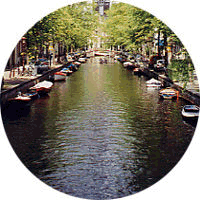
 When
you arrive at Amsterdam's Schiphol
Airport you'll be whisked from your gate with ultra efficiency first to
baggage claim, through customs, then to the Nederlandse
Spoorwegen (Dutch Railways) station located at Schiphol Plaza, the central
hall of the terminal. This ultra modern, hi tech introduction contrasts the
sixteenth century city you are about to discover. Trains from Schiphol Plaza
leave every 15 minutes for Amsterdam Centraal Station.
When
you arrive at Amsterdam's Schiphol
Airport you'll be whisked from your gate with ultra efficiency first to
baggage claim, through customs, then to the Nederlandse
Spoorwegen (Dutch Railways) station located at Schiphol Plaza, the central
hall of the terminal. This ultra modern, hi tech introduction contrasts the
sixteenth century city you are about to discover. Trains from Schiphol Plaza
leave every 15 minutes for Amsterdam Centraal Station.
Amsterdam begins at the brick fronted Centraal Station designed by P.J.H. Cupyers, the architect of the Rijksmuseum. Opened in 1889 the station was built on three artificial islands and 8687 piles. From Centraal Station, Amsterdam Centrum (center) laces out in a cobweb pattern of canals and cobblestone streets.
 The
canals follow a pattern of city walls and drainage ditches built in the fifteenth
to seventeenth century. The straats (streets) and grachts (canals) of Amsterdam
are lined with distinctively tall and narrow canal houses, many dating back
to the 1600's. There's an certain romance about the storybook canals at night
and a depth of cultural heritage in its great art museums; but there are also
prostitutes displaying their wares opposite the city's oldest church.
The
canals follow a pattern of city walls and drainage ditches built in the fifteenth
to seventeenth century. The straats (streets) and grachts (canals) of Amsterdam
are lined with distinctively tall and narrow canal houses, many dating back
to the 1600's. There's an certain romance about the storybook canals at night
and a depth of cultural heritage in its great art museums; but there are also
prostitutes displaying their wares opposite the city's oldest church.
For many, Amsterdam's world-class museums and galleries such as the Rijksmuseum, with its collection of seventeenth century Dutch paintings, and the Van Gogh Museum are reason enough to visit. For others there is sightseeing and shopping centered around Dam square, The Anne Frank House, canal boat tours and nightlife in the Rembrandtsplein, Leidseplein and Waterlooplein neighborhoods.
 Far
from the fashion of Paris and the clubs of London, Amsterdam enjoys an unpretentious,
relaxed atmosphere of intimate bars, canal-side cafes and summer festivals.
For the first time traveler to Europe, Amsterdam is an ideal introduction.
The city is easy to navigate, has excellent public transportation and almost
everyone speaks English, sometimes better than in the United States or London.
Far
from the fashion of Paris and the clubs of London, Amsterdam enjoys an unpretentious,
relaxed atmosphere of intimate bars, canal-side cafes and summer festivals.
For the first time traveler to Europe, Amsterdam is an ideal introduction.
The city is easy to navigate, has excellent public transportation and almost
everyone speaks English, sometimes better than in the United States or London.

